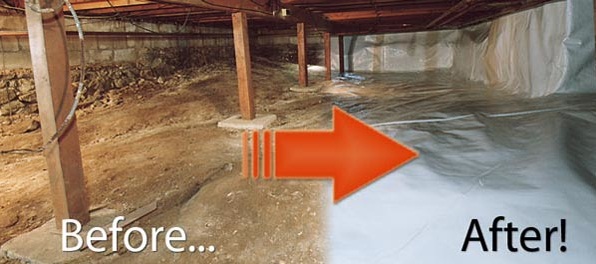
How many people live in your home?
For the first time in 160 years, household sizes are increasing. If you’re living in a full house, you already know how important it is to maximize every square foot of space.
The more room you have to store your belongings and move about freely, the better your quality of life can be! That’s why homeowners like you, are so excited about learning how to utilize their crawl space.
Don’t let your crawlspace just sit there collecting dust and mold. Instead, it’s time to clear it out and put it to use once and for all.
What exactly goes into making your crawlspace more usable? Read on to find out.
Table of Contents
Safely Removing Hazards and Debris
What exactly does crawl space cleaning entail? After all, it’s an area of your home that gets very little foot traffic and usually goes unmonitored.
Years of neglect can cause all sorts of debris and dirt to build up quickly without knowing about it! The first step we advise is to inspect your crawlspace at least once a year and clean it whenever necessary.
Cleaning your crawlspace is a lot easier than you might think. First, you’ll need to remove any debris that’s present.
Crawlspace debris can make it challenging to keep your space safe. Debris includes hanging asbestos insulation, outdated pipes, rusty nails, and other types of construction waste. Get rid of all of it.
Clearing Out Mold and Pests
Your next step will be to remove any mold or pests present. The moisture in your crawlspace can attract rodents, termites, and other pests.
Set up traps for rodents and insects once you have all of the debris out of the way. Your next step will be to remove any mildew or fungi growing.
Keep your eyes open for normal white mold and the dangerous toxic black mold. You might hire a professional mold removal service since it can be a safer option.
Have you ever used pesticides in your crawlspace? There might be traces of the pesticides still present.
If you don’t have the proper protective gear, call a professional cleaning company. Exposure to rodent droppings, mixed with pesticides, can be deadly under certain conditions.
Crawl Space Encapsulation
Did you know that dirt can contribute gallons of moisture every day?
The best thing to prevent future mold will be to invest in crawl space insulation. You can visit sites like https://www.insulatekansascity.com/crawl-space-insulation/ to get a ground cover estimate. A ground cover or vapor barrier will cover every inch of dirt in the crawlspace.
Before installing the ground cover, you’ll need to remove any standing water. As we discussed earlier, you’ll also need to thoroughly clean the crawlspace.
You can move forward with the ground cover installation when everything is in tip-top condition, and you’ve passed your inspection.
When you make your crawlspace, the best ground covers are going to be heavy polyethylene plastic sheets.
Polyethylene plastic works well because it can resist deterioration by mold. As long as you cover the sheets with a few inches of sand or gravel, you’ll be able to keep things in place.
Do you live in a new construction home? If there’s already a ground cover, make sure that it’s overlapping by at least 2 ft.
Does the vapor barrier not overlap? Then it needs a high-quality sealant that adheres to polyethylene plastic. It’s also a good idea for the poly sheets to go up the wall a few inches.
The ground cover sheet should at least make it to the grade line. The grade line is the height of the soil outside of the crawlspace.
Schedule a Crawlspace Inspection
Are you unsure what condition your crawlspace is in? Then it’s time to schedule a usability inspection.
During the inspection, professionals will be able to look for excessive moisture, insect infestations, mold growth, and foundation cracks.
The inspectors will also be able to check for any hazardous materials, poor vapor barriers, malfunctioning wires, and bowing framework. A crawlspace inspection is a good idea if you’re moving into a new home. Even if you’ve been living in your home for a while, a thorough inspection can help point out areas of improvement.
What to Expect on Inspection Day
What exactly are the inspectors going to do? Crawlspace inspections begin at the entry point.
If the crawlspace entry point isn’t large enough, the inspector will report the inspection as a failure. You’ll have to put up a better entrance door before continuing the inspection.
Superficial inspections are when the inspector goes inside the crawlspace. During a superficial inspection, inspectors will look for anything that’s a major hazard.
Mold clusters, broken electrical circuits, and structural damage will be noted. If any major problems are found during the superficial inspection, you can expect your crawlspace to fail. You’ll have to get it back up to code before your inspection can go on.
Finally, there are full inspections. Following a superficial inspection, the inspector will be able to get further into your crawlspace.
They’ll be able to identify any weak spots or potential future problems. You’ll also be able to get expert advice about waterproofing solutions so you can keep your house safe from mold.
Enjoy Using Your Crawlspace
You deserve access to every inch of your home. Now that you know the top tips for cleaning and inspecting your crawlspace, you can start taking action!
If it’s been a while since you’ve cleaned your crawlspace, hire a team of professionals today. Professional crawlspace cleaners will already have the protective equipment and tools necessary.
Once your crawlspace is nice and clean, schedule a usability inspection. Before you know it, you’ll have the best clean, moisture-proof crawlspace around.
What could other tips help you improve your home? Read another article to find out.